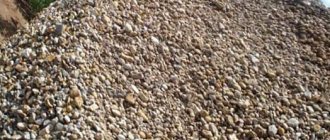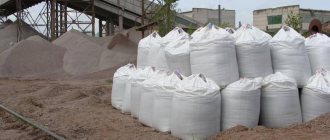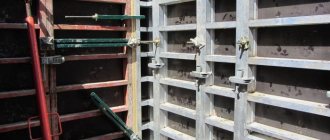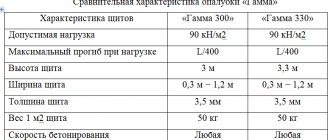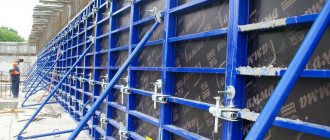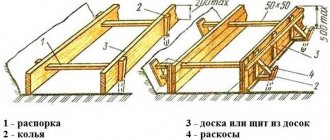Small panel formwork structures are universal sets of lightweight collapsible elements. Due to their minimal weight and versatility, they are in demand both in large above-ground and underground construction, as well as in individual construction; there is no need for lifting equipment for transportation and installation. The segments are easily and simply combined, which makes it possible to use small-panel collapsible formwork for the construction of objects of any complexity: foundations, high supports and beams, ceilings, tanks, pools, wells and shafts.
In addition to manual and quick installation, the advantage of the technology is the durability and reusability of profiles, panels and fasteners. Payback is achieved after 10 cycles of operation with a minimum turnover of panels up to 60. Depending on the need, in different cases it is advisable to buy a new or used set, or rent formwork for a single use.
Description of design
The standard system includes: panels made of multi-layer plywood or high-quality metal, fastenings, supporting and connecting elements. The raw materials for manufacturing are structural steel, wood, moisture-resistant plywood, synthetic fibers and fiberglass. Corners and elements that can withstand high loads are made of the most durable material; for ease of sliding or moving up and down, the boards have special perforations or embossing on the profile.
To protect against corrosion and the alkaline effects of concrete, the surface of small-panel formwork is painted with special compounds or galvanized. Modern technologies make it possible to create wear-resistant and durable frames with high geometric accuracy; turnover reaches 300 cycles. The panels can be connected on either side; fixing is not difficult even for a non-specialist.
The area and weight of the individual elements are small; the average size of the formwork rarely exceeds 2 m2 with a maximum of 50 kg of panel (and in some cases less). Even ready-made prefabricated blocks weigh up to 60 kg. This allows the technology to be used without the use of lifting equipment, regardless of the height (or depth) of the building being built.
The formwork can withstand concrete pressure from 40 to 80 kN/m2, the joints are designed taking into account the requirements of tightness, which has a positive effect on the quality of the concrete surface and minimizes labor costs when removing panels. Fasteners are placed at any required angle, which allows the technology to be used to create both vertical walls and horizontal ceilings, as well as for non-standard pouring options.
What is small panel formwork
Classic formwork is a wooden structure. Most of its elements are thrown away after pouring concrete. It's a completely different matter if you plan to use reusable formwork. It is held together with bolts and nuts using an electric impact wrench.
If you are planning to build a foundation or a house using reusable formwork technology, be sure to have this tool - an electric impact wrench! Without it, the entire productivity of the process will come to naught, and the speed of construction will be even lower than that of a conventional wooden one.
Elements of small-panel formwork
Small-panel formwork is a type of reusable formwork. It consists of elements that weigh up to 70 kg. They can be installed by one or two people without the use of a crane.
This is very important for private foundation construction, since it is usually carried out by one or two people, without the use of construction equipment.
Its element consists of a steel frame and deck. Metal or bakelite plywood is used as a deck. This deck can withstand up to 300 concrete pouring cycles.
Installation stages
Having prepared the panels, it is allowed to install the formwork structure. If it is necessary to pour a strip-type foundation, the shields are placed on both sides of the trench, fixed with spacers inside and additionally reinforced with retaining elements outside.
To build a wide base, the structure is supplemented with slopes, which at one end rest against the ground and at the other support the base. After this, panels are erected, installed vertically and fixed with wire.
Often, in the manufacture of formwork, laminated plywood sheets are used, forming a smooth surface. The panels are pulled together using pipes and wire.
Factory structures made of plastic or metal are assembled directly on the construction site. It is necessary to strictly follow the installation recommendations, connecting the panels with clamping mechanisms and bolts. Such large-panel formwork is a kind of constructor, on the correct assembly of which the quality of the reinforced concrete monolith depends.
Scope of application
As already mentioned, such formwork is used where construction must be carried out without the use of cranes, with small forces. Another area of its application is curved surfaces. Structures such as bridge supports, silos at water treatment plants and cement plants, and chimneys have a curved surface. To bypass it with a minimum error, small-sized elements are used.
Small panel formwork
Also used for the construction of foundation walls in sliding formwork. In the classic form, for this type of construction it is necessary to use hydraulic jacks. In private construction, it is difficult to provide a construction site with jacks in the required volume, so they use surrogate methods - the formwork is simply rearranged in height several times, using technological holes in an already completed concrete wall as a support, into which support rods are inserted. This technology will be very convenient for a private developer - you can rearrange the foundation formwork once a day, pouring a small amount of concrete each time and leaving it to harden overnight.
General terms
Formwork of this type has a perfectly flat surface Formwork of this type has a perfectly flat surface All types of formwork have the following requirements:
- Rigidity. The thrust forces created by the solidifying mass must be compensated by structural elements, fasteners, and posts without deformation, formation of gaps, or plane displacements. It is also necessary to take into account variable loads that arise during pouring and reinforcement work.
- Moisture resistance. Water from the solution should not be actively absorbed by the material. This quality is created by impregnating wooden parts with water-repellent compounds and using waterproof materials both for manufacturing and for covering the contacting surface.
- Integrity. The presence of cracks leads to the leakage of moisture (reduced strength of the monolith), concrete mixture (quantitative losses), and the formation of sagging (additional cleaning work).
- Smooth surface. The formwork panels must be removed without significant effort in separating from the cement surface, dried fragments, or splicing the fibers of the form with the material of the product. The planes are assembled end-to-end, without overlapping each other.
Tools for work
As already mentioned, the main tool for the job is an electric impact wrench. You will have to twist the nuts a lot and for a long time; doing this with a wrench is very difficult. And so - you can easily install formwork in a day where a regular carpenter installs it in a week.
However, the classic wrench cannot be discounted. Typically, bolts and nuts with a head size of 19 mm are used for fastening (the size depends on the manufacturer and type of formwork). Have a pair of keys of this size.
To quickly assemble the formwork, you need an electric impact wrench
You will also need a plumber's hammer, a small sledgehammer, a crowbar and a pry bar to dismantle the formwork.
Like any other formwork, it must be protected from concrete adhesion. Although bakelite plywood is slightly susceptible to this, it is nevertheless better to be on the safe side. Used machine oil is used to process small panel formwork. It is necessary to treat the shields with oil before they are fastened, in disassembled form.
Quite often, when working with such formwork, it is necessary to use ersatz methods, for example, inserting ordinary wooden sections of formwork due to the fact that it is not possible to cover the entire volume using standard elements. Therefore, it is necessary to stock up on ordinary carpentry tools if you have to do such work.
For marking and measuring tools, you will need a water level and a regular level, a tape measure, and a bright-colored marker so that it can be seen on dark bakelite plywood. To mark the concrete pouring level, use a tapping cord, which is treated with white chalk so that it is visible on a dark surface. Since it is impossible to damage bakelite plywood by driving nails, you will have to hold it with your hands in two places while marking, together with an assistant.
Installation Features
Depending on the type of small-panel formwork, the concreting conditions differ slightly. The modular system is joined at the corners; there is no need to fix the bottom edge with reinforcement thanks to the springs in the fasteners. The panels located opposite each other are connected with coupling bolts and tightened with nuts, the top and end - with spacer bars. Fasteners are covered with plastic covers to protect the metal from cement, this extends service life. This approach is more suitable for pouring horizontal screeds, which is why modular floor formwork is used more often than collapsible formwork.
When installing a small-panel adjustable kit, preparatory earthworks are carried out with the obligatory compaction of the trench. Corners and elements require additional reinforcement and auxiliary supports. The assembled box is placed according to the design position, adjacent panels are secured to each other. The cement mortar is poured using a deep vibrator, the formed surface is smoothed and leveled. After the concrete has hardened, the walls are freed from the formwork, it is cleaned and assembled in the next area.
The cost of individual elements of small-panel (galvanized) formwork is:
| Name | Purpose | Dimensions, m | Weight, kg | Price, rubles |
| Linear shield | Basic set of wall formwork | 0,3×0,9 | 14,25 | 2 230 |
| 0,3×1,2 | 18,4 | 2 700 | ||
| 1,2×1,5 | 65,3 | 7 700 | ||
| Universal shield | Columns and walls | 0,9 | 45 | 5 300 |
| 1,2 | 53 | 6 500 | ||
| 1,5 | 65 | 7 300 | ||
| Additional element | Addition of linear shields in increments of 5 cm | 0,1×0,9 | 8,9 | 2 130 |
| 0,1×1,5 | 14,45 | 2 700 | ||
| 0,25×1,5 | 23 | 4 100 | ||
| Angular hinged shield | Forming an internal and external corner | 0,9 | 15,5 | 2 900 |
| 1,2 | 20,7 | 3 500 | ||
| 1,5 | 25,8 | 3 700 |
The price directly depends on the quality and functionality; universal kits with a wide range of panel sizes are more expensive, especially if they have galvanized protection (like MSK, Trimex and many other domestic manufacturers). But thanks to their high turnover, they have a good payback; the ability to connect in any order allows you to quickly build any structure: foundation, beams, columns, walls, shafts or an indirect surface.
Nomenclature of formwork. Materials for work
Small panel formwork consists of a standard set of panels and corners. Additional formwork elements - horizontal crossbars, telescopic racks, couplers. This entire system is held together with bolts, nuts and wedges into one large shield of the foundation wall or load-bearing wall of the house.
Typically, manufacturers do not supply their formwork with fasteners. So you will have to buy the bolts and nuts yourself. Since they are often lost and used in large quantities, it is better to take hardware with a reserve. Before doing this, you need to clarify what hardware is used in the formwork of a given manufacturer.
Fastening the formwork using wedges.
The panels vary in thickness. Typical board thickness sizes are 75, 100 and 150 mm. 150 mm panels are used where larger elements are assembled from small-panel formwork, and they need their own load-bearing capacity so as not to deform when moved by a crane. In ordinary private construction, it is most rational to use panels with a thickness of 75 mm.
Use formwork from the same manufacturer and the same thickness for construction, otherwise you will have problems fastening it into one large mass.
By type, there are main and additional panels. The main panels have a length from 600 to 1500 mm and a width from 300 to 900. Again, the size range greatly depends on the manufacturer. The main panels are used to fill the main area with formwork.
Additional panels are used to fill the remaining volume until the required size is obtained. They have a length from 300 to 1500 mm and a width from 100 to 400 mm.
Corners are used to secure the boards at the corners of the structure. There are external and internal. They vary in height. Typically, in construction, corners that are longer than the height of the wall are used, since they do not interfere with the pouring of concrete. If necessary, they can be fastened in several pieces to obtain the desired height.
Crossbars are used to impart longitudinal rigidity to a row of panels. This is a square or round pipe that is attached to the panels using special brackets. Telescopic posts and struts are used to support the formwork on the base if it is located at a certain height. Often used with sliding formwork technology and when setting the first row. Screeds are necessary to fasten opposite walls together.
We will also mention some ersatz elements - wooden wedges for leveling the boards in height, sections of square pipe that are inserted into the wall for support when rearranging the sliding formwork, some other elements, the presence of which depends on the type and technology of construction of each object.
Design versions
Block panel formwork for columns
The shape of the shield can be flat, angular, or figured. The design profile is assembled using unified standard blanks or supplemented with specially manufactured fragments. Detailing involves the use of horizontal floors, vertical walls, inclined passages, and vaults in the construction.
There are the following types of formwork:
- Fixed;
- Horizontally movable;
- Sliding;
- Collapsible;
- Lifting and adjustable;
- Block.
Sliding occurs without disassembling the mold due to the force of the jacks. Compliance with the vertical axis and horizon is ensured by additional alignment systems. A continuous monolith is obtained from the limited space of the forming structure.
Work technology
Installation of small-panel formwork
The most important thing is to first draw up technological drawings of the foundation formwork. Agree in advance with the supplier what elements are available and how many, and draw up a detailed drawing so you know where and how many elements need to be supplied. Please note that the vertical seams of the rows of panels must be offset in each row relative to the previous one by at least 150 mm. Therefore, you will definitely have to use additional shields.
Then you need to deliver all the elements to the construction site, check the nomenclature and begin construction. Before the first installation, all elements are cleaned of old concrete stains and treated with used machine oil. When rearranging, repeat cleaning and processing each time.
At the beginning of work, you need to have an already connected reinforcement frame. If not to the full height, then at least to a height greater than will be covered by the formwork, so that later it can be increased if necessary. Installation of the foundation formwork begins from the highest point of the base. Place corners and shields in the corners, fix them in a vertical position using removable temporary supports, and check the position.
Check not only the vertical position, but also the correct positioning on the construction site! Otherwise, the foundation walls will turn out to be skewed, and the whole house will be positioned crookedly!
In the case when the foundation walls have a small thickness, which cannot be covered with standard elements, inexpensive foam plastic is used to increase the thickness of the walls and facilitate concreting. The foam can then be removed.
They install the first row of panels, level them vertically and horizontally, and check them. Then the subsequent walls are mounted, placing pairs of wooden wedges under the panels to ensure one level with the first wall. Before filling, the gaps between the foundation slab and the bottom of the boards with wedges are laid with a small pile of concrete and allowed to set a little so that nothing leaks.
They mount all the shields, check the position, knock them in where necessary with a sledgehammer, install ersatz wooden inserts and pour concrete. After the concrete hardens, the panels are removed. In the case of sliding formwork, the procedure is repeated several times - the panels are rearranged and poured until the top point of the wall is reached. Watch the video of how the small-panel formwork is installed.
Varieties
Depending on the design, they distinguish: small-panel modular formwork and a collapsible support system (adjustable inverter). In the first case, the kit consists of elements of a fixed size, replaced as they wear out. They are combined into larger blocks weighing about 50 kg or long panels, which is important when carrying out individual construction (for example, when pouring a foundation in one stage or creating a pool with a non-standard configuration). But at the same time, labor costs for assembling or dismantling modular structures increase, and their turnover is minimal.
The collapsible system consists of a set of load-bearing panels, a removable deck, locking fasteners and mounting elements. A special feature is assembly in any required plane, which allows this type to be used for pouring floors, multi-stage foundations and radial structures.
The mounting elements weigh no more than 30–35 kg, the dimensions are within 60x180 cm, which makes the system easy to transport, operate and store. A huge advantage of collapsible formwork is its high turnover rate - within 200-300 cycles, and versatility. The arbitrary order of elements and connections allows you to create complex architectural forms, even curvilinear ones.
There is a huge variety of ready-made kits with a specific purpose, for example, in the range of the MSK small-panel system there are steel formworks for:
- curved surfaces;
- foundations, tanks, wells, mines;
- complex nodes;
- walls;
- columns of different heights;
- bridge supporting structures.
Main characteristics
When purchasing small panel formwork, the following parameters and properties are taken into account:
1. Frame and deck material.
2. Weight indicator, kg/m2.
3. Permissible load and deflection (determined according to GOST R52085-2003) - up to 0.6 kPa.
4. Frame and deck turnover.
5. Profile thickness and panel dimensions, mm.
6. Availability of anti-corrosion protection.
7. Fastening method used.
Positive features include:
- Convenient and lightweight components.
- A wide modular network of individual elements that can be combined with each other.
- Accuracy and speed of assembly into a single unit.
- No requirements for weather conditions during operation and storage.
- High reliability and durability.
- Long service life.
- Saving space and working time.
Installation of small-panel frames allows for quick pouring of strip foundations, wells or tanks for a septic tank with any complexity of configuration. The latter is especially relevant when carrying out individual low-rise construction.
Economic expediency
Small panel removable formwork is quite an expensive proposition. As practice shows, in private construction, purchasing a complete set is an unaffordable luxury. It will only pay off if you build a fairly large house and use elements not only for the foundation, but also for monolithic concrete walls, which are then insulated from the outside. Or build several houses.
Therefore, for most private developers it will be more convenient to rent a set of formwork from a construction company.
When receiving, try to check that all the panels are in good condition, cleaned of dirt and have no chips on the surface of the plywood, since most likely you will receive formwork that has already been used several times.
Advantages and disadvantages
Due to its small size, Korean small-panel formwork can be used in high-rise construction or in the construction of private buildings whose height is no more than 6 m. This is due to the ability to independently manually install such a system, without resorting to the use of special equipment. Other advantages of such formwork are:
- Possibility to use shields of various sizes;
- The versatility of the components used, as well as fasteners;
- Ease of connecting elements into a single system;
- The ability to combine elements of different sizes;
- High strength of panel products;
- Long service period;
- Saving money and time due to low weight and no need to use special equipment;
- Ease of implementation in various projects.
At the same time, despite the presence of positive aspects, the use of such structures also has its negative aspects:
Installation requires the involvement of a large number of people who will manually install and secure the boards;
The appearance of the created surface is an order of magnitude inferior to those options that are created using other types of formwork.
The procedure for installing such a system is determined by the type of structure itself. So, in order to install collapsible options, you need to perform the following steps:
- First, it is worth carrying out land work, which consists of digging a trench, as well as laying a cushion of sand and crushed stone;
- Next comes the installation of auxiliary elements, shields, as well as special corners;
- Now install adjacent panels, which are secured using spring hooks;
- After this, the finished box is straightened and brought into the desired position;
- The last stage is pouring the concrete mixture into the resulting structure and subsequent deep vibratory ramming of the solution.
In order to prevent expansion of the lower parts of the formwork by the poured mixture, it is important to drive medium-diameter reinforcing bars into the ground at intervals of 1 meter. The installation process for modular options is carried out in the following sequence:
The installation process for modular options is carried out in the following sequence:
- After preparing the trench, other blocks are connected to the corner shield using fasteners. Due to the springs that are present in the connecting parts, the formation of gaps is prevented;
- Next, the individual walls of the structure are assembled, for which tension bolts are inserted, onto which special plastic tubes are placed to prevent the negative impact of the solution on the metal;
- The last stage is the creation of a supporting frame. To do this, panels installed in parallel are fastened with special connecting locks. Additionally, they are connected at the top and bottom with spacer bars, after which the cement mortar is poured.
The process of dismantling the small-panel formwork structure is carried out in the reverse order. However, when constructing a large number of similar elements, for example, when the parameters of walls or load-bearing structures are the same on all floors, complete dismantling of the system is not required. Here, thanks to special brackets located on the upper parts of the shields, the entire structure can be raised to the desired height, and then secured there. In addition, the system can be rearranged in assembled form by simply removing the supporting frame.
The use of small-panel formwork options is a profitable and convenient way to fill a foundation, walls or other elements
This design comes in several types, so it is important to consider the features of each of them.
Description of the design, proposed varieties
The standard universal kit includes panels with a profile made of high-strength steel and galvanized metal and a deck made of moisture-resistant plywood or fiberglass, fastening, connecting and supporting elements. All of them are designed for operation under high loads and are protected against corrosion and the alkaline effects of concrete. Multifunctionality is achieved due to the ability to rotate and connect elements from any side, move them up or down thanks to special perforation and a diverse system of fasteners.
Depending on the degree of turnover, they are divided into one-time use structures installed during the construction of unique objects, and inventory ones. The number of cycles of using the latter among modern manufacturers reaches 200-300; they pay for themselves due to repeated installation for 7-10 cycles. In private construction, the second type, which has standard dimensions, is in demand.
There are small-panel modular formworks and collapsible formworks. The standard equipment of the first type includes lightweight elements with small and standardized dimensions (within 1x1.5 m), spacer bars, connecting handles and corner or straight leveling beams. The latter are responsible for increasing the blocks in height. The advantages include maintainability (there are no problems when replacing individual elements), the ability to form arbitrary-shaped surfaces and combine blocks into larger systems; this type is in demand when laying foundations and walls.
Small-panel collapsible formwork is a set of familiar rectangular elements connected in any order. It has a wide range of applications and is used for concreting foundations, horizontal floors, walls, flights of stairs, inclined and curved structures. The standard dimensions of one shield do not exceed 60 cm in width and 1.8 m in height, the weight of the equipment within 27 kg allows installation without the use of special equipment.
Depending on the intended purpose, there are:
- Wall, including foundation formwork, systems for pouring curved surfaces, elevator shafts, complex assemblies and ordinary vertical walls. Most often they are of the modular type and are suitable for gaining unlimited height in increments of 250 mm. Their advantages are light weight and the ability to replace any unit (maintainability).
- For columns assembled from universal panels or ready-made modules. Depending on the size, they are used for laying bridge supports or erecting standard vertical structures in residential buildings.
- Pavements, for forming supports of any height and complexity.
The advantages of such a structure
Before moving on to the specifics of using formwork, we would like to highlight several advantages that such foundation formwork has over other options. For example, large-panel formwork is significantly inferior to it in many respects. So, about the advantages:
- As we have already said, the weight of the components is quite small, which makes installation much easier, especially if you do not have the opportunity to use a crane and a large number of workers.
- There are completely different sizes of parts for such formwork. A wide selection will allow you to create exactly the structure that is required for your specific construction, the shapes and sizes needed for construction. Regular large-panel formwork, unfortunately, does not have such variety.
- All connections are attached very precisely, which ensures high strength and improves all other qualities. It is the small size of the shields that makes it possible to achieve such precision in work.
- Installation is very quick and reliable; if necessary, such a structure (aluminum or made of other materials) can remain assembled for quite a long time.
- Modern shields, made of various materials, provide high quality, while being completely unpretentious to storage conditions.
